Revista Electrónica de Investigación Educativa
Vol. 9, No. 1, 2007
Construction of a Scale-Questionnaire on the Attitude of
the Teaching Staff as Opposed to the Educative
Innovation by Means of Techniques of
Cooperative Work (CAPIC)
Joan Andrés Traver Martí
jtraver@edu.uji.es
Departamento de Educación
Facultad de Ciencias Humanas y Sociales
Universitat Jaume I de Castelló
Avda. Sos Baynat s/n
12071 Castelló, España
Rafaela García López
Rafaela.Garcia@uv.es
Departamento de Teoría de la Educación
Facultad de Filosofía y Ciencias de la Educación
Universitat de València
Avda. Blasco Ibáñez Nº 31
46010 València, España
(Received: November 23, 2005;
accepted for publishing: January 31, 2007)
Abstract
In the present work the construction process of a scale-questionnaire is described to measure the attitude of the teaching staff as opposed to the educational innovation by means of techniques of cooperative work (CAPIC). In order to carry out its design and elaboration we need on the one hand a model of analysis of the attitudes and an instrument of measurement of the same ones capable of guiding its practical dynamics. The Theory of the Reasoned Action of Fisbhein and Ajzen (1975, 1980) and the summative scales (Likert) have fulfilled, in both cases, this paper.
Key words: Educational innovation, teachers attitudes, cooperative learning.
Introduction
The scale-questionnaire to measure the attitude of the teaching staff as opposed to the educative innovation by means of techniques of cooperative work (CAPIC) forms part of an investigation done to improve the attitude of solidarity of the pupils by means of techniques of cooperative learning. Although from the point of view of the design and the fundamentation of the investigation process we could operate a practical proposal, we are conscious of the real limitation the educative innovation supposes in the classrooms. Due to it, in the investigation design we contemplate the previous accomplishment of a course of formation of the participant teaching staff in the experience, that allowed them to work the necessary knowledge and learning necessary to put it in practice in the classroom. At the same time, given the importance that the educational attitudes have respect to the innovation processes, and from the hypothesis that " a more theoretical-practical knowledge of the proposals of educative innovation on the part of the teaching staff will improve its attitude as opposed to the practical implementation of the same ones ", we designed an investigation instrument in order to direct us in the assessment of the attitudinal changes suffered by the participant teaching staff, and to verify to what extent the formation theoretical-practical processes improve the educational attitude respect to the progress and professional improvement. This it is the context of investigation and the reasons of work by which we decided to construct the CAPIC. In order to carry out its design and elaboration we used like theoretical model of analysis of the attitudes the Theory of the Reasoned Action of Fisbhein and Ajzen (1975, 1980) and as a model of instrument of attitudinal measurement the summative scales (Likert).
The CAPIC was validated by means of a study done to a sample of 32 teachers of non university (primary and secondary) education of scholastic centers in the province of Castellón (Spain) and applied successfully to the group of participant teaching staff in the described investigation.
I. Methodology of work and process of elaboration
Within the instruments of quantitative character used in the evaluation of attitudes, the scales of attitudes have been the most important techniques and of much application. They consist of providing a questionnaire with a list of statements (classical scales of attitude) or with bipolar adjectives (semantic differential) and asked the polled to answer in accordance with some degrees, according to their feelings or attitudes.
The scales of attitudes allow us to infer the attitudes from the answers the subjects give to a series of phrases or adjectives. In the particular case of the scales of attitudes type-Likert, before a set of declarations in form of statement and that reflects verbalized opinions – attitudes about the measured subject, the subject must value its f agreement-disagreement degree with these statements among five or more degrees, represented numerically. This model of measurement of attitudes is the simplest one, but not for that reason less trustworthy. Really, it is used in the measurement of attitudes in education. Likert extended to the measurement of attitudes that was normal in the measurement of the personality features.1 In this way, we can affirm that the sum of a series of supposedly homogenous answers to items puts the subject in the measured variable (Morales, 1984).
The methodological guideline which we have followed throughout the process of construction of the scale to a large extent responds to the proposal done by authors such as Hennerson, Morris, y Fizt-Gibbon (1978, pp. 138-142), and that we summarized in two basic steps:
- To enumerate characteristics or manifestations related to the attitude.
- To assign levels of relative importance to the diverse analyzed characteristics, in order to write up much more amount of items related to the most important features.
Another practice we have incorporated in this process has been the use of the opinion of judges or experts in that subject matter, to verify the adjustment of the characteristics related to the new constructo that is desired to be measured; practice used in other occasions (Mínguez, 1988; Escámez, Ortega and Saura, 1987; Escámez and others, 1993; Ruíz, Brotat and Sentís, 1977; Pérez Samaniego, 1999, Hirsch, 2005), and that favors a greater precision in the elaboration of constructo.
In the definitive elaboration of the CAPIC we have followed the following criteria and passages of general application the design and preparation of attitudinal scales (Morales, 1984; Rodríguez, 1989; Arce, 1994; Bolivar, 1995):
- Conceptualization. Suitable atmosphere and subject of the field that is going to be studied, with the purpose of covering with items the main dimensions with constructo that is wanted to be measured.
- Writing of ítems. In general, there are three minimum conditions to be considered in the construction of a scale:
- Items must cover a wide sample of universe of the content to which constructo of the scale refers to.
- Simplicity in the expression of items: excellent content for which it is tried to evaluate, accessible and clear for everybody.
Analysis of items. Items have to be designed so that they do not invite to slanted answers. They will be answered with own criteria, to avoid2 the assent and the social wish.
- Criteria of psychometrical character. destined to guarantee the unidimensionality in the measurement, which allow us to obtain constant values of the studied phenomena (representativeness of the sample, calculations of reliability and validity, etc.) And to make analysis and quantitative interpretations of the results.
- Validation of the content. Besides to make statistical analysis to control the degree of validity of items and the own scale, by means of the calculation of statistical coefficients, the written up total of items should be put under opinion of experts (judges), with the purpose of selecting the most suitable and discriminatory ones.
1.1. Process of elaboration.
The steps followed for the elaboration of Scale-Questionnaire CAPIC, have been the following ones:
a) Identification of the features that characterize the educative innovation by means of techniques of cooperative work. A representative public and private sample of 86 people belonging to the educational group of non university educational centers, chosen at random in the province of Castellón (Spain), who answered, writing down, the following questions: " In his/her opinion enumerate the advantages that you consider more excellent in the application of methods of cooperative work among the students within the classroom. Thanks."
The totality of the characteristics obtained, after doing the consultation, was compiled in a listing of declarations, with the purpose of making a categorization that allowed us to group them in the main declaracional nuclei, that identified the majority opinion of the teaching staff on the educative innovation by means of techniques of cooperative work.
b) Categorization of the characteristics and calculation of frequencies. Three experts in cooperative learning categorized the listing of declarations that gathered the different characteristics identified by the consulted sample. As a result of this process of categorization, they a rose a set from 42 different categories. Later, the calculation of frequencies was made, whereupon each one of the characteristics in the categories that we had established appeared identified.
c) Valuation on the part of the judges. From the resulting listing of the categorization of the features those categories whose frequency was below 10% (frequency = 8.6) were misestimated, obtaining a total of 15 categories that gather those that have more partner-professional acceptance, and therefore more representativeness (+ 10%), obtained in the sample.
The resulting listing of categories went to criterion of valuation on the part of a jury of professionals and students of the education, experts in the thematic subject matter of study. The jury was made up of a total of 7 people, experts in this area of work/theme, implied neither direct nor indirectly in the investigation.
The members of the jury were asked for valuing each one of the characteristics or resulting categories, scoring them from 1 to 10 according to the relation degree that in their opinion kept with the task made by means of cooperative work groups in the classroom. To this end, a sheet of anonymous valuation was given to them, in which besides they must specify their academical-professional entailment with the thematic object of analysis, also they were asked for valuing the degree of relation of each one of the categories with respect to the work in cooperative groups as didactic strategy, assigning a numerical score to them.
d) Election of the most significant features. Once the frequency of each category has been calculated and the valuation has also been made, on the part of the judges, the most significant ones have been chosen taking care of the agreement of both valuations and eliminating those that were not considered significant.
After having misestimated those categories whose frequency was located below 10%, of the single resulting listing those that obtained a numerical score average on the part of the judges smaller or equal to 73 were chosen. As a result of this operation one of the items was eliminated from the questionnaire as it obtained an average score by criterion of judges of 6.8 points.
In the following table we can observe which were the selected categories, shown to the existing agreement between the frequency and the valuation of the judges (Table I).
Table I Categories selected based on the frequency and the valuation of the judges
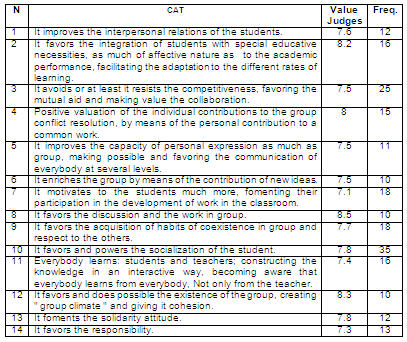
e) Construction of the scale-questionnaire on the attitude of the teaching staff as opposed to the educative innovation by means of techniques of cooperative work. Once selected the categories that received a much more rank of importance we went on formulating them, in attitudinal terms, by means of the elaboration of items corresponding to each one of them.
In its formulation, we left from the theoretical frame on the attitudes of the reasoned action of Fishben and Ajzen (1975, 1980). We did carefully the elaboration of a minimum of 2 items by each category, so that it allowed us to specified with more amplitude in its meaning. At the same time, and to avoid that a mechanical answer could be given, looking for a greater implication of the teaching staff to which later we passed the questionnaire, we were alternating some formulations in positive sense with others in negative sense. The elaborated attitudinal statements of items, as well as its relation with the categories that originate them, we can observe them in the picture that appears next (Table II).
Table II. - Relation of attitudinal items elaborated from the selected categories
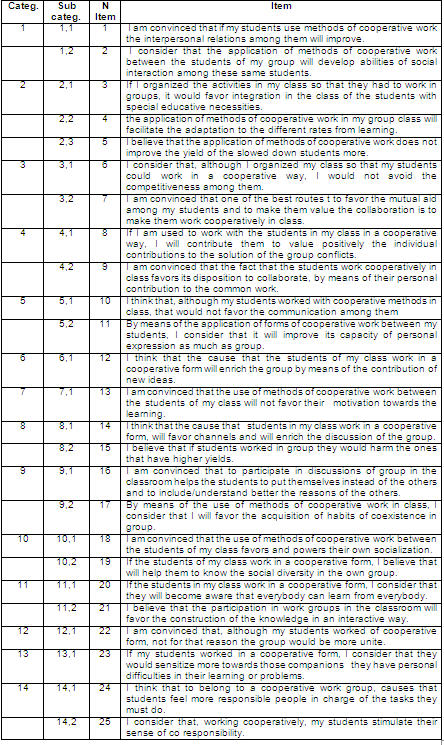
From the relation of attitudinal items formulated, we went on elaborating the first rough draft of the CAPIC (Questionnaire 1) to measure the attitude of the teaching staff as opposed to the educative innovation by means of techniques of cooperative work. From this first questionnaire and after being validated we went on elaborating the definitive questionnaire.
II. Analysis of results: Reliability and internal consistency of questionnaire CAPIC
In order to validate questionnaire capic a pilot study was made with a sample of 32 professors of egb, bup and fp of scholastic centers of the province of Castellón (Spain). The results have been analyzed by means of statistical program spss. In the first place we made the analysis of the reliability and internal consistency of questionnaire 1 of the CAPIC, considered as first rough draft, that consists of 25 attitudinal items. Based on the reached results and considering the observations that the professors made, we eliminated those items that presented/displayed a negative or low internal correlation (< 0.3). From the total items of the questionnaire 1 we eliminated 6 items, going to be constituted the definitive version of the CAPIC by a total of 19 items. On this last version of the CAPIC we have returned to make the analysis of reliability and internal consistency, in which an improvement of the coefficient is observed alpha of Cronbach and the internal correlation of all items is positive and superior to (> 0.5).
2.1. Reliability and internal consistency of questionnaire 1 (first rough draft):
In order to know the reliability questionnaire 1 of the CAPIC we will make the calculation of the coefficient of reliability (alpha of Cronbach) and of the indexes of homogeneity of items, allows us to obtain the measurement of its internal consistency.
a) To reliability coefficient:
Alpha of Cronbach = 0,9072
The obtained measurement of the coefficient of reliability of questionnaire 1 of the CAPIC is high.
b) Homogeneity indixes (Table III):
Table III. Homogeneity indexes items of questionnaire 1 (first rough draft).
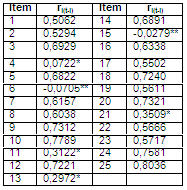
In order to find the homogeneity indexes we calculated the correlation of each item with the total of the questionnaire, to which previously the contribution of the item has taken it off (r I(t-I). Although in the calculation of the reliability coefficient we have obtained one alpha of Cronbach elevated enough, we have eliminated those items that present/display a negative index of homogeneity (**), and those others that they present/display an inferior correlation to (r I(t-I) < 0.5 (*). In this way, we obtain a new formulation of the questionnaire CAPIC that presents/displays a sensible improvement of the coefficient of reliability and the indexes of homogeneity of his items, and that at the same time, when reducing the number of items is easier to administer. Eliminated items have been: 4, 6, 11, 13, 15, and 21. Next, we will go on analyzing the reliability of the definitive version of questionnaire CAPIC.
2.2. Reliability and internal consistency of the questionnaire CAPIC (definitive version):
In order to know the reliability questionnaire CAPIC we have made again the previous analysis, but with the new version of the questionnaire.
a) To reliability coefficient:
Alpha of Cronbach = 0,9381
As we can observe, a sensible improvement of the reliability coefficient is appraised that is located in a quite high value.
b) Homogeneity indixes (Table IV):
Table IV. Indexes of homogeneity of items of questionnaire CAPIC (definitive version).
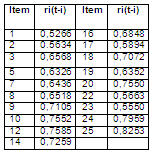
The indexes of homogeneity of items selected locate all over the value (r I(t-I) > 0.5, increasing sensibly the internal consistency of the questionnaire.
III. Definitive elaboration of the questionnaire
With selected items we went on elaborating the definitive questionnaire to measure the attitude of the teaching staff as opposed to the educative innovation by means of techniques of cooperative work (Table V).
Table V. Scale-Questionnaire about the attitude of the teaching staff as opposed to the educative innovation by means of techniques of cooperative work
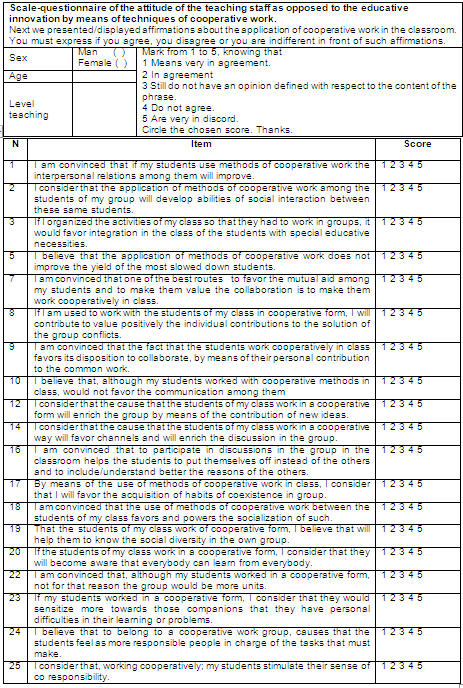
IV. Discussion
In accordance with the results reached in the validation process we can affirm that, as an instrument of investigation and attitudinal measurement, the CAPIC offers a high level of reliability and an adapted internal consistency. Results that advise their suitability to be used as tools of measurement of the educational attitude before the operated processes of technical educative innovation when implementing in class of cooperative learning.
Taking into account the results from Traver and García (2004) and Traver (2005), we can appreciate the successful use of scale-questionnaire CAPIC to value the attitudinal change produced in the teaching staff when working the attitude of solidarity of the pupils by means of the Puzzle Technique of Aronson. As an instrument of attitudinal measurement was used, in an effective way, to value the attitude of the teaching staff in front of the educative innovation and the attitudinal change that takes place when this didactic technique is used in the classroom.
In its practical application its behavior was adapted, being easy to administer and to correct, offering a suitable analysis of the attitudes subject matter. From the methodological point of view it is an affluent instrument constructed and with a good fundamentation theoretical-practice from the attitudinal field. Reasons that, from we have aimed, indicates the pertinence of their practical use.
To know the attitudes the teaching staff in front of the proposals of practical innovation and to develop elements of educative action that cause a suitable educational attitudinal change they constitute key elements in the processes of formation and educative improvement. Instruments of work as attitudinal scale-questionnaire capic can help us to continue advancing in this winding but stimulating way. This one, humbly, is our pretension.
References
Arce, C. (1994). Técnicas de construcción de escalas psicológicas. Madrid: Síntesis.
Bolívar, A. (1995). La evaluación de valores y actitudes. Madrid: Anaya.
Escámez, J., Falcó, P., García, R., Altabella, J., & Aznar, J. (1993). Educación para la salud: un programa de prevención de la drogadicción. València: Nau llibres.
Escámez, J., Ortega, P., & Saura, P. (1987). Educar en la solidaridad: programa pedagógico. Revista Española de Pedagogía, 178, 499- 528.
Fishbein, M. & Ajzen, I. (1975). Belief, attitudes, intention and behaviour. An introduction to theory and research. Massachussets: Addison- Wesley.
Fishbein, M. y Ajzen, I. (1980). Understanding attitudes and predicting behavior. Englewood Cliffs, NJ: Prendice Hall.
Hennerson, M. E., Morris, L. L., & Fizt-Gibbon, C. T. (1978). How to measure attitudes. Beverly Hills, CA: Sage.
Hirsch, A. (2005). Construcción de una escala de actitudes sobre ética profesional. Revista Electrónica de Investigación Educativa, 7 (1). Retrieved July 31, 2005, from: http://redie.uabc.mx/vol7no1/contenido-hirsch.html
Martínez Agut, P. (1999). Las actitudes de los maestros en formación inicial de la Comunidad Valenciana hacia el Medio Ambiente. Unpublished doctoral dissertation, Universidad de Valencia, Spain.
Mínguez, R. (1988). La tolerancia en alumnos de la Escuela Universitaria del profesorado de EGB. Unpublished doctoral dissertation. Universitat de València, Spain.
Morales, P. (1984). Medición de actitudes en psicología y educación. San Sebastián: Tártalo.
Pérez Samaniego, V. M. (1999). El cambio de las actitudes hacia la actividad física relacionada con la salud: una investigación con estudiantes de magisterio especialistas en educación física. Unpublished doctoral dissertation, Universidad de València, Spain.
Rodríguez, A. (1989). Interpretación de las actitudes. In A. Rodríguez & J. Seoane (Eds.), Creencias, actitudes y valores. Tratado de psicología general (Vol. 7, pp. 199-314). Madrid: Alhambra.
Ruíz, M., Brotat, E., & Sentís, J. (1977). Elaboración de una escala de actitudes hacia las enfermedades psíquicas, el psiquiatra y la psiquiatría. Revista de Psicología General y Aplicada, 32, 877-886.
Traver, J. A. & García López, R. (2004). La enseñanza de la actitud de solidaridad en el aula: una propuesta de trabajo centrada en la aplicación de la técnica puzzle de Aronson. Revista Española Pedagogía, 229, 419-437.
Traver Martí, J. A. (2005). Trabajo cooperativo y aprendizaje solidario: Aplicación de la técnica puzzle de Aronson para la enseñanza y el aprendizaje de la actitud de solidaridad [CD Magna Collection, Num. 5]. Castelló, Spain: UJI-Editorial Universitària.
Translator: Lessie Evona York-Weatherman
UABC Mexicali
1We do not have to confuse both concepts: the attitudes are valorative and are aimed at specific objects, whereas the characteristics of personality are more global and they do not need an explicit external referent to have sense (Morales, 1984: 4).
2In psicometria, by assent the tendency in the answers of the individuals is understood to be in agreement with the situation described in the items. This phenomenon can be avoided or be corrected introducing and alternating items which present a positive writing with others whose formulation is negative.
3The judges were instructed to give the value since 7 of those characteristics related to the intention of measurement. This criterion has already been used in the construction of other attitudinal questionnaires, as for example the one of Martínez Agut (1999) and Pérez Samaniego (1999).
Please cite the source as:
Traver, J. A. & García López, R. (2007). Construction of a Scale-Questionnaire on the Attitude of the Teaching Staff as Opposed to the Educative Innovation by Means of Techniques of Cooperative Work (CAPIC). Revista Electrónica de Investigación Educativa, 9 (1). Retrieved month day, year from: http://redie.uabc.mx/vol.9no1/contents-traver.html




